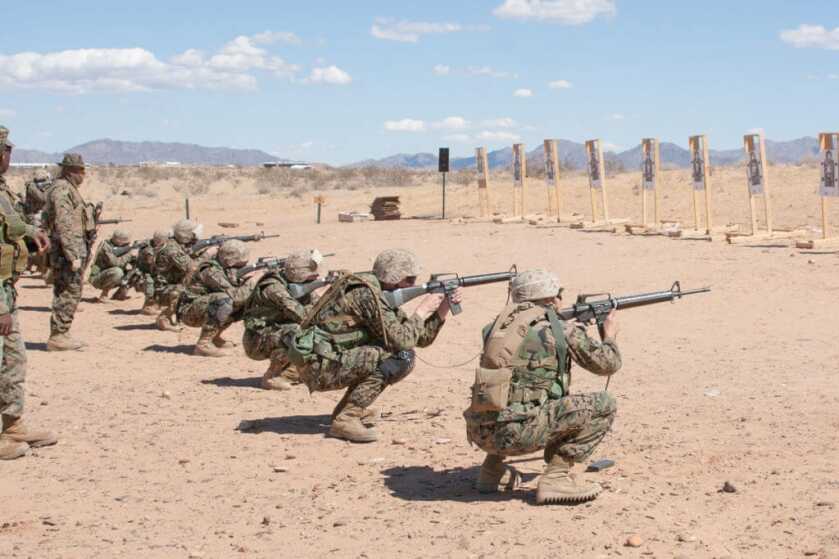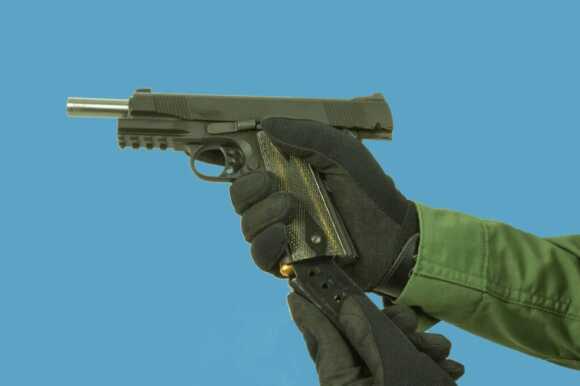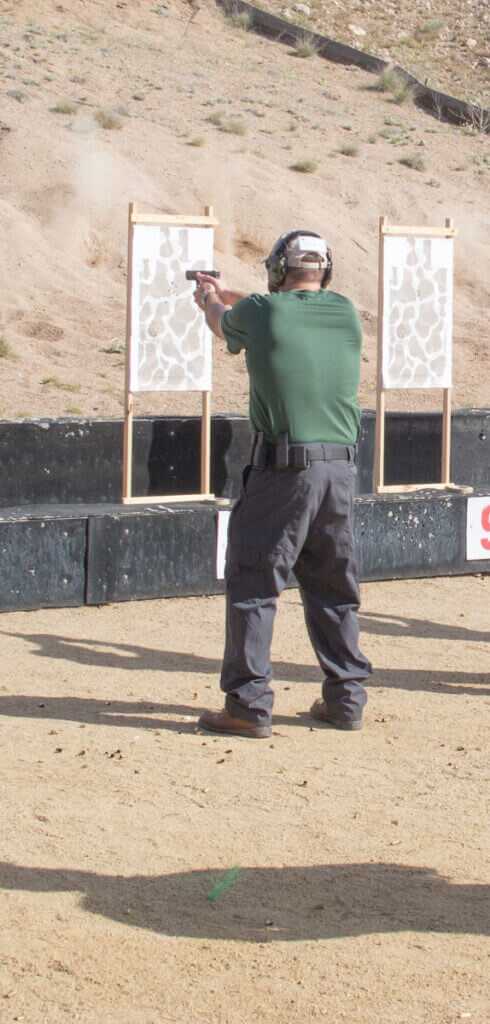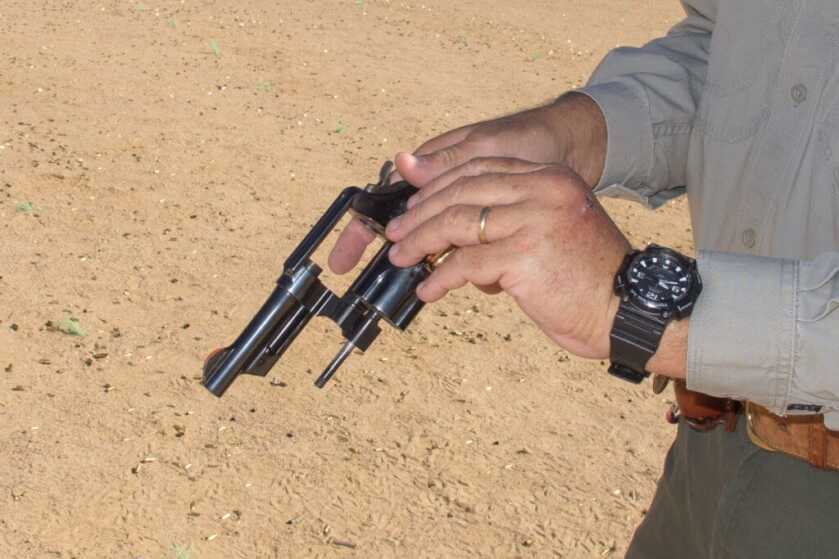MANIPULATE YOUR GUN AUTOMATICALLY WITHOUT THINKING ABOUT IT
Instinct may be the wrong word to describe it because instinct implies that it is something you are born knowing how to do. And that is definitely not the case with manipulating or handling a gun. Some American men think they are born with that ability, but they are not. Correct gun handling must be learned and then practiced.
What we are discussing here is the importance of proper and efficient gun handling or manipulation and being able to do it automatically without thinking. You may think that if you know what to do with a gun in a certain situation, you will just do it and then move on. But under stress, with many things to consider, people do not “rise to the occasion”. Instead, people fall back to their level of training.

Here’s an example. Paul Gardner was a Marine Rifleman when he was deployed to Iraq in 2003. And on 12 Apr 2003 while in Iraq he was severely wounded in a firefight. That injury caused him to be paralyzed from the waist down. In an article he wrote that was published in S.W.A.T. Magazine in March of 2010, he says positively that if he had taken the right training from a quality instructor and learned how to properly manipulate his gun before deployment, he would not have been wounded the way he was and would not have been paralyzed as a result of that wound. He also acknowledges that besides learning the skills necessary to manipulate the gun, he would have had to practice them until he would do them automatically.
In his article, Gardner tells in detail how he went about reloading his M16 and how it got him shot. The point he makes is that if he had known how to properly do something as seemingly simple as reloading, had been able to do it without thinking, and had been standing in a proper gunfighter’s stance, he is positive that he would not have been shot the way he was. The Marine Corps taught him how to reload his rifle on the rifle range, but never how to do speed or tactical reloads. If he had done those things correctly and learned to do them instinctually, he is certain that he would not have been shot, at least the way he was shot. That’s pretty good testimony that proper instinctual gun manipulation is important in a gunfight.

Gunfights are fast, nasty affairs that most often are over in seconds. Things happen very quickly and the stress level is high. There is no time to waste because you want to stop the other guy before he can shoot you. Speed is important. But rushing to get things done can make you fumble things, and the possibility of fumbling is increased when someone is trying to shoot you.

Because of the speed needed and the stress involved in a gunfight, it is important to be able to perform tasks automatically, without having to think about them. Recognizing that something needs to be done, then deciding what to do, then doing it, takes a lot longer than just doing it automatically. And if you happen to be in a match, although the stakes are different, speed is critical if you want to win.

To be clear, we are discussing the technical aspects of gun handling, not the tactics necessary to win a match or prevail in a gunfight. Tactics are things like use of cover, movement, or identification of targets, all of which are important in a gunfight or a match. Technical aspects though include things like trigger press, reloads, and malfunction clearing. It’s manipulation or how the gun is handled that are discussed here.
And it is very important to get training that is relevant to what you might be doing with the gun, whether it is a rifle, carbine, or handgun. What is appropriate training for competition is probably not exactly what a soldier bound for war or a non-sworn civilian on the streets of America needs to know.
So get good training in the basics, even if only for a few hours. Make sure the instruction comes from a reputable instructor or institution like Gunsite Academy or Trident Concepts where Gardner trained. Once you get trained, it’s important to practice what you have learned, and make sure you are doing it right.
Mistakes have a way of creeping into techniques without you knowing you are doing something wrong. So it helps to do repetitions in class while an instructor watches what you do. It has been said that a minimum of 1,000 repetitions must be done before a person can perform a task automatically, without thinking about it. I don’t know if that is true, but it does take more than a few repetitions on training day. So keep practicing and make sure you are doing what you have learned the way you were taught.

Your training in the basics should include doing manipulations from unusual positions and under unusual conditions. That’s because you cannot predict what is going to happen in a gunfight and you may find yourself on the ground or even having to shoot around or under some type of obstruction. And don’t try to figure out how to do those things on your own. Get good instruction so that you don’t hurt yourself in training.

Although you may not be able to do many repetitions in unusual conditions in class, it’s good to have some experience doing those things so that you have an idea of how to do them if needed. You just can’t invent something in the middle of a fight – there’s no time. If the need to do something unusual that you have not practiced comes up in a real fight, at least you will have had some experience dealing with unusual situations and you may be able to apply some of that experience to the current situation.
Repetition is key to doing things automatically, or instinctively, without having to think about them. But you must know how to do them correctly because if you practice repeatedly doing something the wrong way, that will be the way you do it under stress. So get quality instruction from an instructor who can watch you perform and correct mistakes.
What is “the wrong way” to do something? It depends on what the task is. The wrong way may work most of the time, but has a greater chance of not working than doing something the right way. And often the wrong way is okay and will work every time, but there is a faster way. And being faster is often what it takes to survive a gunfight or win a match.
There are many techniques for manipulating a gun, whether a long gun or a handgun, and they can be different depending on the type of action – i.e., revolver, semi-automatic, slide action, or bolt action. Techniques that the shooter should be able to do instinctively include changing a magazine or using a speed loader. There are different ways to use each and some work better than others. For example, it is usually faster to insert a magazine in a handgun if the flat surface of the magazine is indexed with the flat surface of the magazine well before the magazine is driven home. But many shooters do not know that, so fumble around trying to line up the magazine with the hole which can take more time.

Some people call being able to do something automatically, the most efficient way, unconscious competence. And there are different levels of competence. But getting to the point that you can manipulate the gun without thinking about it, fast and correctly, is really at the core of why training is so important. Again, there is no time in a gunfight or a competition to figure out how to manipulate the gun, draw it, or get it running quickly. So these things, and others, should be learned and practiced in training.
There are four levels of competence. The lowest level, level one, is unconscious incompetence. It means that the person doesn’t even know what he or she doesn’t know. That describes many shooters, especially those know-it-alls who think they know what they are doing and that anyone who doesn’t do it their way, doesn’t know anything.
Level two is conscious incompetence. A person in this category realizes there are things he does not know. This is the first step in getting to where the person can do things automatically under stress.
The next level, three, is conscious competence. A person at this level has been taught how to do something, can do it, but still has to think about it before and while doing it. To get to the next level, the student needs to practice the technique many times and must practice doing it correctly. This usually requires a good instructor to observe the student while performing the technique so any errors that creep into the student’s performance can be immediately corrected. If the errors are not corrected and the student keeps doing them in practice, they will be ingrained into the student’s performance and will be done that way under stress.
Level four, the highest level, is unconscious competence. When the shooter is able to perform the task correctly, automatically, when under stress, without thinking about it, that level has been reached. When the stimulus happens, the technique is performed. An example is the gun is fired until it is empty. Immediately, without even thinking about it, the shooter replaces the magazine and gets back into the fight. That may include shooting immediately or just assessing the situation to determine if another round needs to be fired. But the point is, there is no hesitation or conscious thought involved in getting the gun reloaded.
Can you go from standing to prone and perform a speed reload at the same time? A shooter at level four can. If the shooter is at level three, it is likely that they will have to think about what they need to do and then perform one task, like reloading, and then go to prone. But both techniques can be done at the same time, very quickly. To do it though requires many repetitions for most people.
There is more than one way to do many things, and often, more than one way works. But whatever method you choose, make sure you do it correctly to lessen the chance that something goes wrong when you are doing it for real. And practice doing it the right way until you can do it without thinking, automatically. Get to level four.
That’s the what and the why of it.

Article was very informative. Easy read and great information. Thanks
After leaving the Marine Corps in 1969 I joined the police department. As was the fire arms training at the time immediately after firing the practice stage you policed your brass. A few years later my partner and I engaged in a gun fight with a subject. As we drove past the address he stepped out on his porch and shot the rear window out of the scout car. In the ensuing gun fight I fired 6 rounds from my model 29 then reloaded same. After reloading without thinking I picked up the spent brass then reengaged the subject. A few days later I talked to a fire arms instructor and explained my actions. As a result spent brass was not collected until the end of practice or qualification. Reading this article brought back my own embarrassing incident.😀
Good points in this article. I would like to know what method of reloading the Marine (thanks for your service) was taught.
I am a retired LEO firearms instructor. Our primary project was our agency’s Patrol Rifle Program. We taught various methods of reloading in different positions and conditions. That was also part of the PR qualification.
Harley. Thanks for reading and thanks for the thoughtful question. I do not know Gardner, but according to the article, he was standing bladed with his side towards the threat. When his M16 was empty, he took the magazine out of his gun and fumbled around trying to get it back into an empty spot in his magazine pouch. Gardner thought the fight was over, and all of his concentration was focused on reloading like he had been taught to do on the flat, known distance rifle range in training. Finally, he got the empty magazine in the pouch, got a full one in his hand, and inserted it into the magazine well. When he looked up, the enemy was standing there and immediately shot Gardner, striking him in the side instead of hitting his hard plate which would have stopped the bullet.